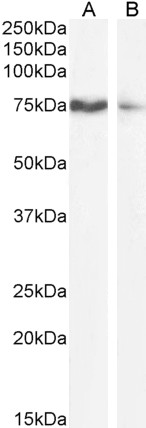
FACS analysis of PFA-fixed HepG2 cells using GTX88295 OATP8 antibody, Internal. Blue : Primary antibody Black : IgG control Permeabilization : 0.5% Triton Dilution : 10microg/ml
OATP8 antibody, Internal
GTX88295
ApplicationsFlow Cytometry, ImmunoFluorescence, Western Blot, ImmunoCytoChemistry
Product group Antibodies
TargetSLCO1B3
Overview
- SupplierGeneTex
- Product NameOATP8 antibody, Internal
- Delivery Days Customer9
- ApplicationsFlow Cytometry, ImmunoFluorescence, Western Blot, ImmunoCytoChemistry
- CertificationResearch Use Only
- ClonalityPolyclonal
- Concentration0.50 mg/ml
- ConjugateUnconjugated
- Gene ID28234
- Target nameSLCO1B3
- Target descriptionsolute carrier organic anion transporter family member 1B3
- Target synonymsHBLRR, LST-2, LST-3TM13, LST3, OATP-8, OATP1B3, OATP8, SLC21A8, solute carrier organic anion transporter family member 1B3, liver-specific organic anion transporter 2, liver-specific organic anion transporter 3TM13, organic anion transporter 8, organic anion transporter LST-3c, organic anion-transporting polypeptide 8, solute carrier family 21 (organic anion transporter), member 8
- HostGoat
- IsotypeIgG
- Protein IDQ9NPD5
- Protein NameSolute carrier organic anion transporter family member 1B3
- Scientific DescriptionThis gene encodes a liver-specific member of the organic anion transporter family. The encoded protein is a transmembrane receptor that mediates the sodium-independent uptake of endogenous and xenobiotic compounds and plays a critical role in bile acid and bilirubin transport. Mutations in this gene are a cause of Rotor type hyperbilirubinemia. Alternative splicing of this gene and the use of alternative promoters results in transcript variants encoding different isoforms that differ in their tissue specificity. [provided by RefSeq, Mar 2017]
- Storage Instruction-20°C or -80°C,2°C to 8°C
- UNSPSC12352203







